The Benefits of Idea Validation and How to Conduct It [Part 1]
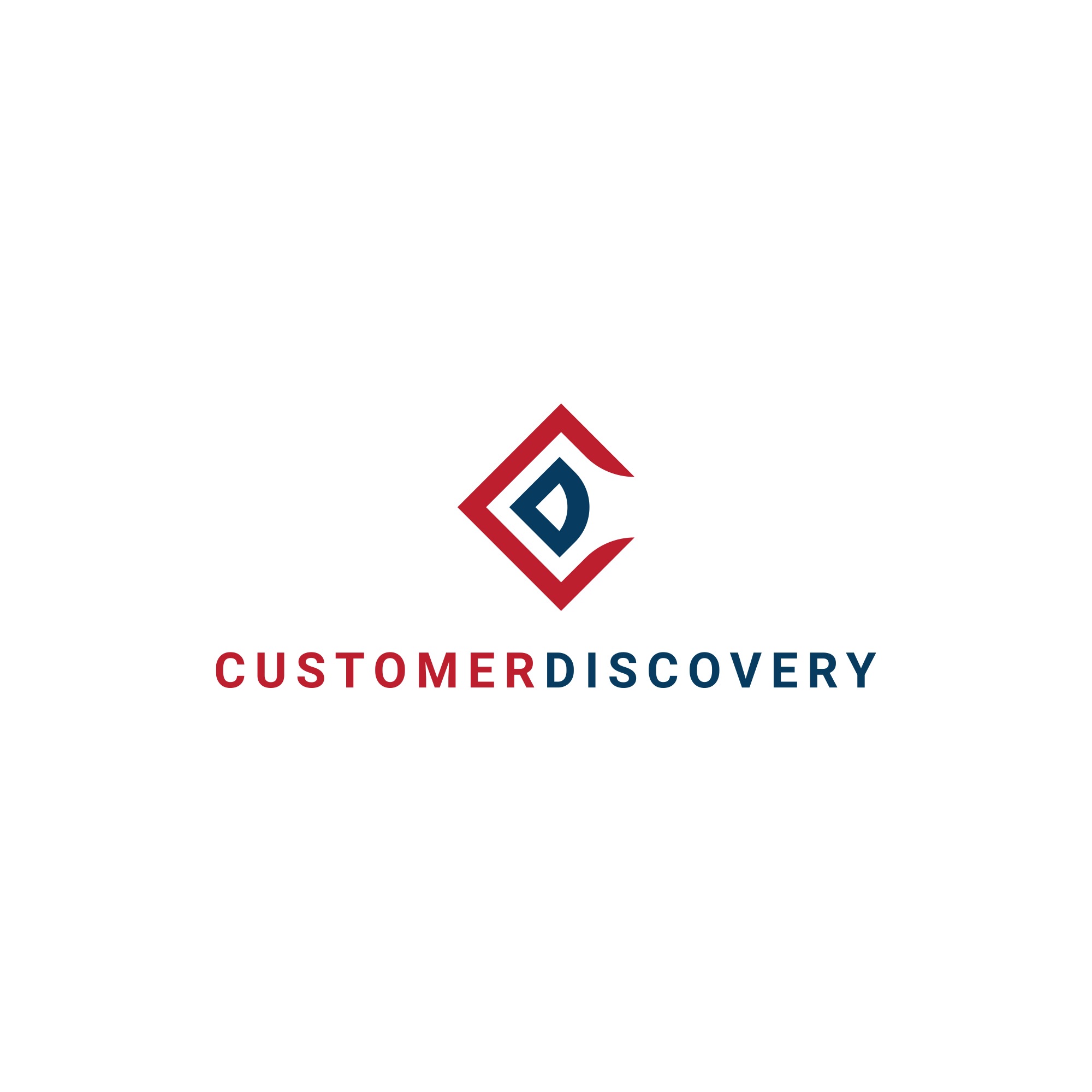
@customerdiscoveryCustomerDiscovery.co
We connect early stage founders with early adopters for idea validation and alpha user testing.
So you have this idea that you think could change the world and transform you into the founder and CEO of a multimillion (or billion) dollar company. You are currently riding up the steep incline of the enthusiastic beginning days of creating a startup. You may or may not have probably stumbled on the fact that 92% of early stage founders fail but either way you’re ready to do what the 8% of the founders that succeed do. You are going to use the scientific approach to validating a quantifiable demand in the market for the idea you have or you will pivot until you do find it. Very smart of you, let’s talk about how to begin.
This guide is for those who are pre product/MVP but are already hellbent on an idea or concept that they want to test in the market to determine if it is worth pursuing or not. At this stage there is a lot more ambiguity than there is concrete facts so you will need to create a structured approach to turning this big idea into user research data points so you have product development insights. Rest assured, this can all be done in 5 steps and in about 30 days although the more time you give yourself the better the outcome will be.
The Purpose Of Idea Validation
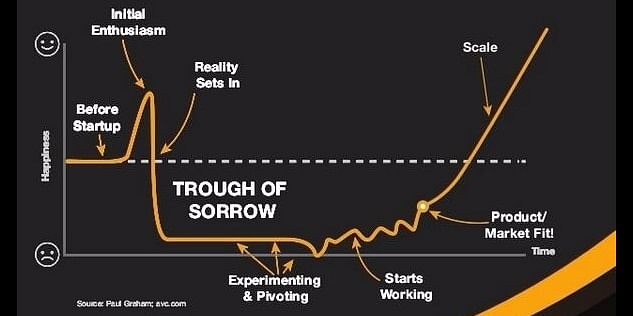
What is idea validation?
Idea validation is the process of gathering evidence around ideas through experimentation to make fast, informed and de-risked decisions. Early on you may be very optimistic about the future success of your idea, but in order to maximize the chances of it being successful you need to ensure that there are people who will pay for what you want to build. In order to do this we will need to validate components of your idea such as the vision, the value proposition, your customer segments, your business model, core feature sets, and more.
What isn’t it?
Idea validation isn’t a way to guarantee your idea will be a massive success. There is no way to reduce 100% of the risk or uncertainty from building a novel product or business out of an idea. However, it can help turn ideas and hopes into data supporting that your idea can be a profitable and scalable business.
Why is it so important?
The goal of idea validation is to lower the amount of ambiguity around how and what exactly to build so you can successfully get your idea into the market. Idea Validation reduces the risk, speeds up the delivery of a value-creating service in the market, and minimizes the costs.
Cindy Alvarez, author of ‘Lean Customer Development’ says it best “Every hour speaking to consumers saves you countless hours and dollars in uninformed product development”.
The core outcome of running an idea validation experiment should be an unbiased, data driven answer to the following question.
How many people want this product and will they spend enough on the product that I can start a meaningful business?
Now that we know the goal of running an idea validation experiment, now it’s time to ask how to create one?! Let’s dive deeper into the 5 core steps of conducting an idea validation experiment and helpful resources for each step.
Step 1: Design Your Validation Experiment
Before you begin asking for other’s time you need to list the critical hypotheses and assumptions that you are testing. This can be especially difficult as we tend to be overly optimistic towards our own ideas potential success so make sure when listing them to be as unbiased as possible. We will also need to format our interviews, so when we are face to face (virtually as it is 2021) with our interviewees we can confidently guide the interview.
List and Convert Assumptions into Falsifiable Hypotheses
Many people consider assumptions and hypotheses as interchangeable terms when in fact they are the difference between qualitative and quantitative. To explain it as simply as possible, if we have an assumption we can either accept the risk or convert it into a testable hypothesis.
Here are 3 examples of turning assumptions into a falsifiable hypothesis
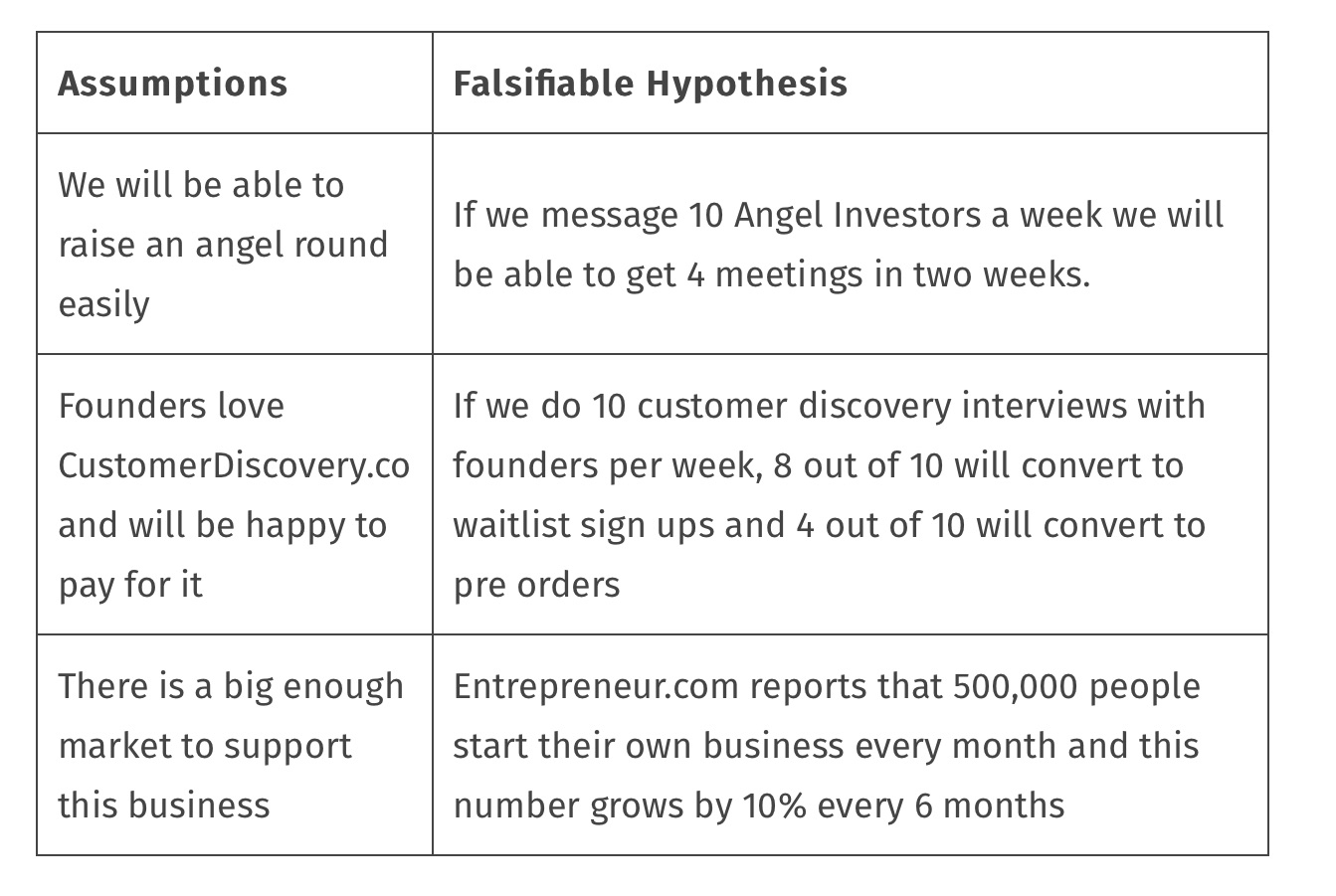
Interview Questions
Once your critical assumptions are converted into testable hypotheses, you will need to write down a list of problem space-oriented questions that can be used to test their validity. It is important to have these questions written ahead of time as it can be very easy to fall into the trap of leading your interviewee to favorable responses.
These questions will serve as the format of your interviews which is important to have as you need to focus on making the most out of the time you have with these people. I have included a list of the first 3 example questions I use for my interviews that you can customize to be more specific to your scope.
1. Thanks for taking my call, I’m doing some research on [main activity related to problem]. Before we start, can you tell me a bit about yourself?
Focus on learning about WHO your customer is before moving onto the problem.
2. When was the last time you [main activity related to problem]?
3. What’s the biggest challenge you face when [main activity related to problem]?
Listen to see if they mention the problem you’re trying to solve.
If not mentioned, then it may not be a big enough problem! Dig deeper into their biggest problem.
Enter your email below for the full list of questions I use for my interviews below to have them sent directly to your inbox. (*JK I think this is against HN rules*)
Defining Minimum Success Criteria
After your interview is formated it is time to set your minimum success criteria (MSC). This is essentially the grading criteria for whether your idea passes or fails the validation experiment. There are two methods to go about defining this metric and you can use them both simultaneously if you prefer.
Method #1: Quick and Easy
If you are interviewing Early Adopters and you want to create an MSC pertaining to how many of them are interested in your product you could say that at least 7/10 of the early adopters you speak to each week should convert into waitlist signups.
You could even go a step further by saying that out of the 10 early adopters you speak to, 2 of them should convert to preorders.
That way you know that if only 40% of the people you interview are
Method #2: Industry Metrics
If you are familiar with average conversion rates in your niche then feel free to use those as baselines to compare your results to. For example, if your industry’s conversion rate is about 5%, then a good baseline metric for you to keep track of is if 5% or more of the people you are talking to are converting to signups.
Step 2: Identify Who Your Potential Early Adopters Are And Where You Can Find Them.
First of all I want to say that at the core of what we are doing at customerdiscovery.co is creating an all in one platform for you to conduct these validation experiments (and alpha user tests) and find these early adopters in our marketplace.
At the time of writing this, we are about 8 weeks out from our own alpha launch so click here to sign up for our waitlist! In the meanwhile, let’s talk about current best practices to find these early adopters.
We will break this down into two approaches. First, we will cover the free methods for founders operating on a budget much as I was (and still am) as I knew if I was willing to put in extra work on a consistent schedule I could get remarkable results from taking advantage of the following resources.
Niche Outreach
I genuinely believe every founder should start here as it provides valuable insight into your early adopters pertaining to the lingo they use, the things that are important to them, how to speak their language, their pain points, and most importantly, how to build something that they will find valuable.
Take the time to add value to the group and answer questions that members may have to earn their trust. This is the simple process of jab, jab, jab, right hook. After you have jabbed a few times (provided value), now it’s time for you to throw the right hook (ask for a favor).
Here’s your right hook that you can post in any of the platforms below, just make sure to earn trust in each community before posting to avoid getting your post deleted or kicked from any communities.
“Hey guys, I’m thinking of [starting a website, creating an app, building a product] around [topic area]. When you talk to your friends about it, what do you say? What do you think is the biggest problem around [topic area]?“
This is a simple and effective post you can make on any platform to stimulate conversation around your idea. People that share your passion and interests will be happy to provide their input, providing you with leads to DM for interviews. Let’s talk more about the different watering holes you can use to find your potential early adopters
Facebook Groups

This is perhaps the easiest method but also one of the most constraining. FB groups can be somewhat dictatorish in nature and if you don’t take the time to provide value and establish a name for yourself before asking the members to help you with validation interviews you could find yourself banned before you know it.
To find relevant FB Groups just type in the most common search keywords and filters to identify which groups are most relevant to your goals. When doing your initial search think of what your potential early adopter would be searching when they would find your product.
While you may apply to join as many groups as you like I would stick to the 10 most relevant FB groups with the highest daily engagement. The quality of engagement matters a lot more than the quantity of groups you are in, you want to be in the room where it happens! (room where it happens, room where it happens…)
If you have one ask per week in each of the 10 groups and 5–10 people respond to each (a conservative estimate) you could potentially have 50–100 interviews scheduled out for the future in one week…and that’s just with Facebook alone just wait until we cover the rest of the platforms.
Here are my top three resources to help you find the best FB groups for your niche
9 of The Best Facebook Groups We’ve Ever Seen
54+ Best Facebook Groups For Entrepreneurs, Startups, And Marketers!
List of the 25 largest Facebook groups (2021 update)

Reddit is arguably the most powerful tool on this list. However, with great power comes great responsibility. Reddit members have oftentimes been referred to as an angry mob but don’t let that scare you away, if you take the time to earn their trust in their community they will band together and provide exponentially more value in your favor.
Identify the subreddits that your early adopters are most likely to be in and join them. However, don’t be too quick to jump in and start asking for research participants. Take the time to add value and earn karma because I believe they limit your ability to post until you reach a karma threshold. Subreddits can be highly engaged and effective places to gather great feedback and validation participants if you put the time in and genuinely share the user’s best interests in mind.
Here are my top three resources to help you find the best subreddits for your niche
Here is a list of the top 17 best subreddits on Reddit (2021 update)

Known as Silicon Valley’s favorite Q & A platform, Quora is a place for educated professionals to speak about intellectual topics.
The hack to quora is creating a stimulating discussion about something pertaining to the problem your product solves. It is important not to drop any links to your product but rather, fuel the conversation and ask thought-provoking questions to the users that respond to get to understand the problem space even better.
This is a great place for gaining a deep understanding of the problem space your idea is operating in. To summarize, you shouldn’t be selling or heavily recruiting on Quora. Instead, use this platform to focus on growing your skills as a thought leader in your space by spreading knowledge.

Hacker News gets over 200,000 unique visitors each day. There are two key components to gathering feedback on HackerNews.
Use the title ‘Ask HN‘ in front of your post title. This is important and it will be added to a thread containing users who avidly answer questions pertaining to new and exciting ideas
Submit your post at 8:00am EST on Wednesdays. Wednesdays have the highest engagement on HN.
Have a catchy title. Think of how many words you can take away from your elevator pitch without taking away from the excitement.
For more guidance on how to successfully post on HackerNews, click here.

Now for the company with by far the best logo. Producthunt is a place where you can go to see the top newest products of the day, every day. On this platform there are makers and hunters, hunters share products that they are fans of which helps makers gain awareness and traffic. I have found a lot of interviewees by reaching out to hunters that have shared products that were similar to my idea. I already knew they were fans of similar products so I thought, why not reach out and see if they are interested in what I’m working on?
This won’t be the place that you get your most targeted early adopters but it serves a very important purpose. It is a hub for Early Tech Enthusiasts who have their thumb on the pulse of what’s new and what’s popular. Networking on this site can help you gain insight and the connections to check out some new similar products that may do something similar to what you aim to do, they may even have the same target audience that you can interview if you’re crafty enough.
ProductHunt is perhaps the most popular of these types of platforms but there are many others, including BetaList and BetaPages.
For us, our early adopters are early stage founders and early tech enthusiasts (Early adopters of various B2C software niches) so we spend a lot of time on producthunt, indie hackers, bettalist, betapages, thehackstack, and many of their alternatives.
That brings me to my next point. If you find that you have clearly identified competitors to the potential product you eventually want to create, make sure to enter them into https://alternativeto.net/ so you can gauge out your competitive landscape and tap into their audience.
Pro Tip: Create a Weekly Schedule and Stick To It
The key to capitalizing on this approach is as simple as converting the 1-2 hours a day you spend on your phone scrolling through Tiktok or Instagram each day into spending 10 minutes on Reddit commenting on posts in relevant subreddits, spending 10 minutes answering questions in FB groups that your early adopters are in, 10 minutes facilitating discussions on Quora, and another 10 searching either Producthunt, Betalist etc.
After the first week of feeling out which groups provide the most insight and ROI the next week then create a schedule of blocking out an hour or two each day to jab(give) and which days of the week you will throw your hook(ask). Most importantly, you should have a goal for that day as well.
Let’s say your day to ask for feedback is Wednesday and you know you will post your hook in 10 FB Groups, 5 subreddits, 1 HackerNews post, 5 Quora groups, and any other platform you prefer. First, plan how long this will take you. Copy and pasting your hook takes about 10 seconds so if you do a total of in 20-25 places that should take you 4- 5 minutes in total.
Next, you need to set an outcome goal for how many people you expect to convert from commenters to interviews. While we could be optimistic and say if 10 people like/upvote your post and 10 more comment then we can multiply that by each post to predict that 400 people convert into validation interviews. However, we know from experience that’s not the way the internet works. It would be more realistic for you to convert 1-2 users from each community on the day you post your ask. That means you can reasonably estimate to gain 20-25 new interviews each week (with some of those interviews converting to pre orders).
20 interviews are more than enough for your initial cohort for your first validation experiment. This gives you enough variety of feedback without an overhwleming amount of people to have to schedule and keep track of feedback and follow ups. I’d recommend starting with around 20-30 people for your first 30 day validation experiments because in subsequent validation sprints you will be building your audience every week and it can compound fairly quickly which can get out of hand before you know it. Repeat this process for 3 more weeks and you can expect to have your first 100 sign ups or more completely free.
**Disclaimer** You may be surprised that I didn’t list Linkedin or Twitter as resources for gathering idea validation participants. I myself just created a Twitter account in 2021 so I can’t claim it as a significant resource for my validation efforts. Linkedin however, I did use sporadically and it was helpful to my goals but it was too hit or miss for me to record a replicable process that I could document and use to add value for others. Not to mention, when I would join Linkedin groups that seemed like they would be great for my needs with a total member count of often 100k-500k, the engagement per post would be lucky to have 1-2 likes. I hardly ever noticed any posts being commented on so I never put the time into posting or prospecting in those communities.
Weekly Time Commitment
We spoke about the importance of creating a schedule so you can carve out time for your daily and weekly activities. Let’s take a look at the estimated time commitment for week 1 vs weeks 2-4
Week 1
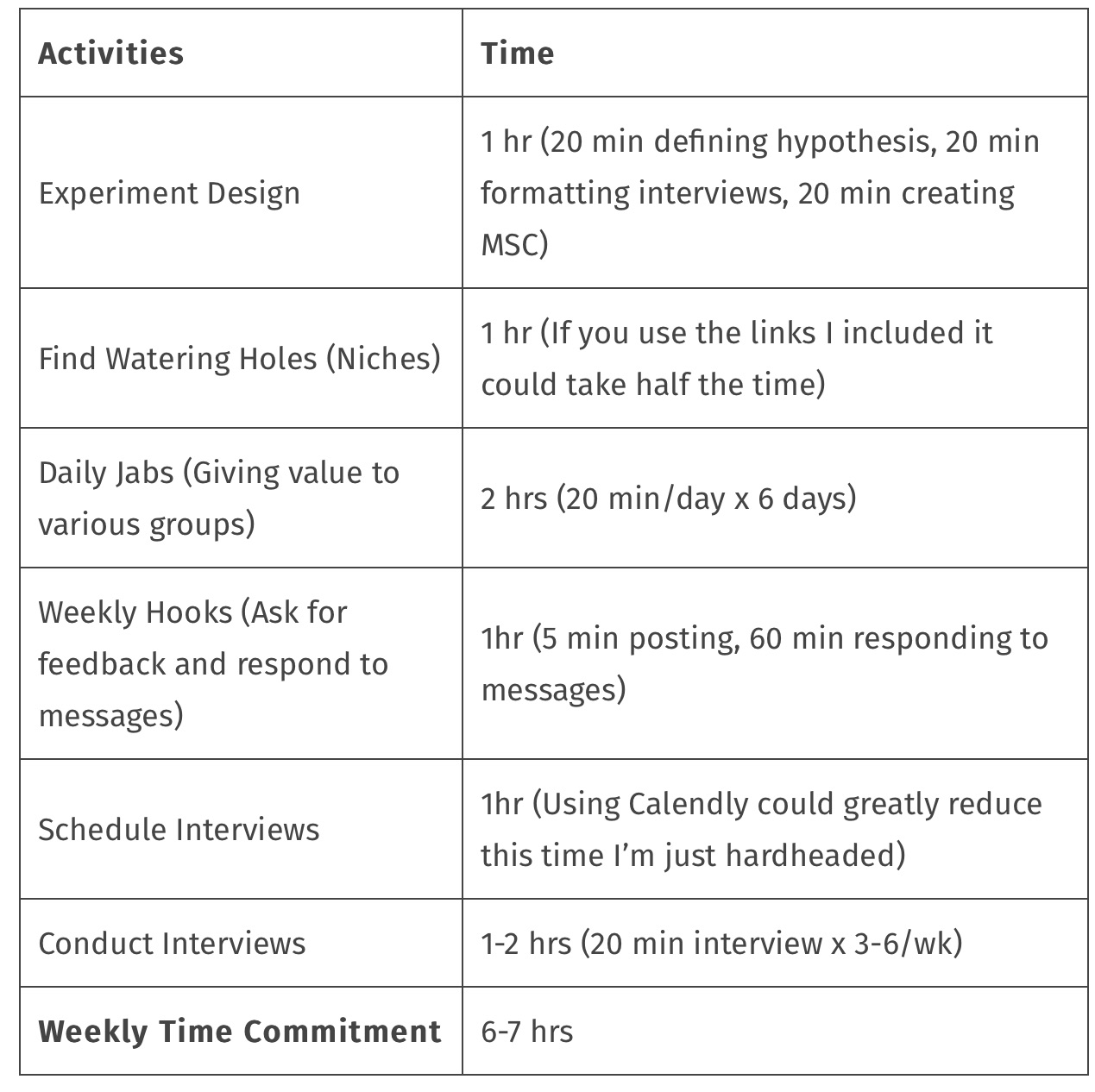
Weeks 2-4
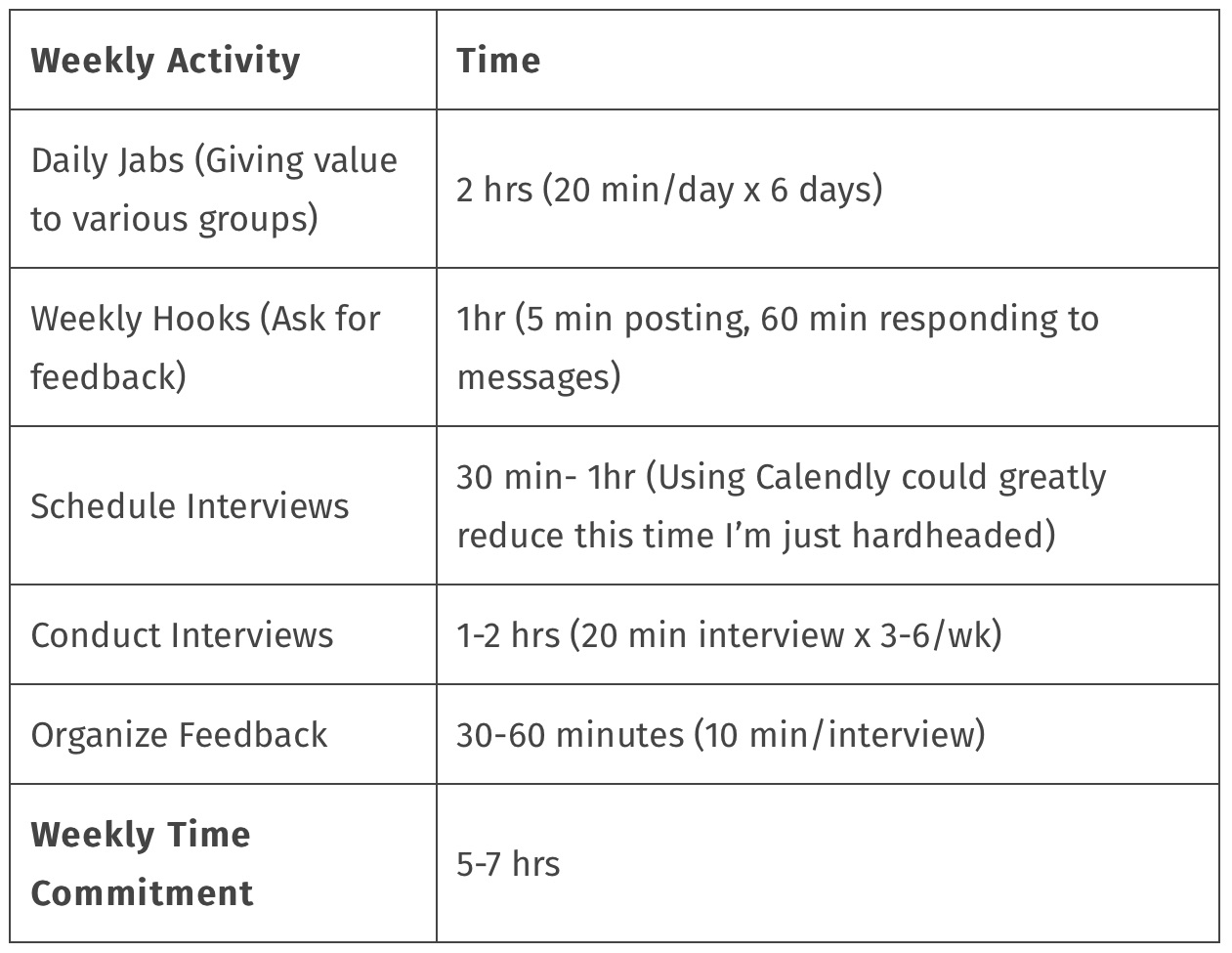
While I tried to be as precise as I could with these time estimates I also know I have been on social media for 5+ years. For those that are newer to social media I would play it safe and carve out 10 hours a week for your idea validation experiment which gives you time to learn the culture of each group you’re in and some of the finer nuances of social media. Best of luck!
Conclusion (For Now)
This wraps up part one of How To Validate Your Idea Within 30 Days For Free. Part two will cover the last 3 steps of the 5 step process which picks back up at Step 3: How to Conduct and Score Interviews.
For early-stage founders, especially those with full-time jobs, it can be tough to keep a schedule to do 5-10 idea validation interviews per week. However preparation is the smart man’s luck and if you set a goal to post in one or more of the locations I included earlier, or allocating a monthly budget that allows for that amount of weekly interviews you should have no problem carving out 2-4 hours per week to meet with the people who will eventually be buying your product.
If you are a founder or an early tech enthusiast who would like to get in touch feel free to Book a call or send an email here.
Sign up for our alpha launch so you can do everything in one place.
Listen to ‘The Customer Discovercast’ for deep dives with Founders and Investors who have used the customer discovery framework to build or invest in successful startups!
Tags
Create your free account to unlock your custom reading experience.

